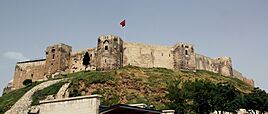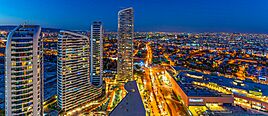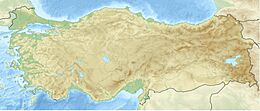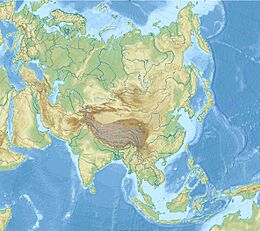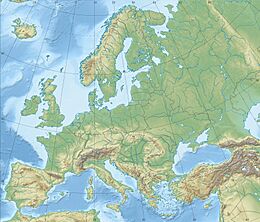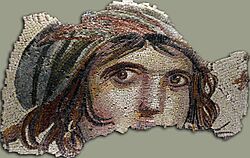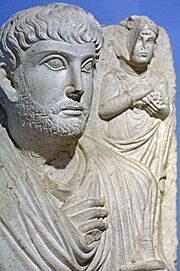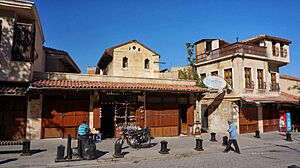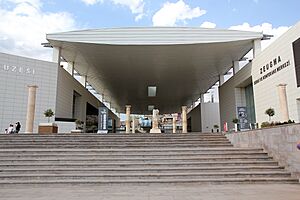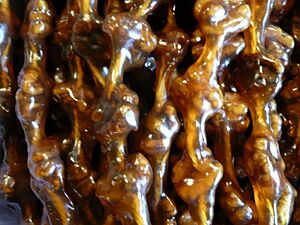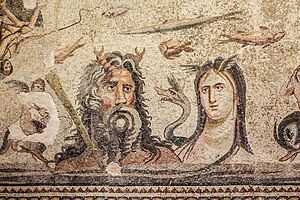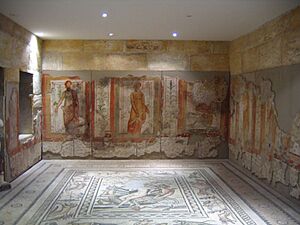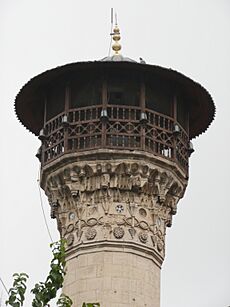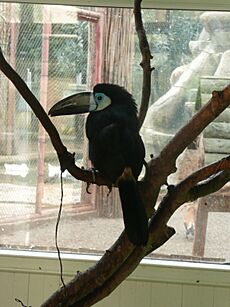Gaziantep facts for kids
Quick facts for kids
Gaziantep
|
||
|---|---|---|
|
Big city
|
||
|
Clockwise from top: Gaziantep Castle, Şirehan, Alaüddevle Mosque, Gaziantep skyline, Büdeyri Hanı and Tahtani Mosque, Liberation Mosque (former St. Mary's Cathedral)
|
||
|
||
| Country | ||
| Region | Southeastern Anatolia | |
| Province | Gaziantep | |
| Area | ||
| • Big city | 6,819 km2 (2,633 sq mi) | |
| • Urban | 2,960 km2 (1,140 sq mi) | |
| • Metro | 2,250 km2 (870 sq mi) | |
| Population
(31/12/2021 estimation)
|
||
| • Big city | 2,130,432 | |
| • Density | 312.426/km2 (809.18/sq mi) | |
| • Urban | 1,808,948 | |
| • Urban density | 611.1/km2 (1,582.8/sq mi) | |
| • Metro | 1,775,904 | |
| • Metro density | 789.3/km2 (2,044/sq mi) | |
| Demonym(s) | Aintaban | |
| GDP | ||
| • Metropolitan municipality | TRY 148.558 billion US$ 16.545 billion (2021) |
|
| • Per capita | TRY 70,228 US$ 7,819 (2021) |
|
| Time zone | UTC+3 (TRT) | |
| Postal code |
27x xx
|
|
| Area code(s) | 342 & 343 | |
| Licence plate | 27 | |
| Website | www.gaziantep.gov.tr | |
Gaziantep is a big city in south-central Turkey. It's the capital of the Gaziantep Province. The city is located in the western part of Turkey's Southeastern Anatolia Region. It is about 185 kilometers (115 miles) east of Adana and 97 kilometers (60 miles) north of Aleppo, Syria. The city sits by the Sajur River. People believe Gaziantep is built where the ancient city of Antiochia ad Taurum once stood. It is also close to ancient Zeugma.
In 2021, the Gaziantep province had over 2.1 million people. About 1.7 million of them lived in the main city area. This makes Gaziantep the sixth-largest city in Turkey. Most people in Gaziantep are Turks. There are also many Kurds and Syrian refugees living here. In the past, many different groups lived in the city, including Turkmens, Armenians, and Jews.
In February 2023, a very strong earthquake hit the city. It caused a lot of damage.
Contents
- What Does the Name Gaziantep Mean?
- A Look at Gaziantep's Past
- Gaziantep's Climate and Weather
- Gaziantep's Economy: A Hub of Trade and Industry
- Who Lives in Gaziantep?
- Gaziantep's Rich Culture
- How to Get Around Gaziantep
- Education in Gaziantep
- Sports in Gaziantep
- Gaziantep's City Layout
- Gaziantep's International Connections
- Famous People from Gaziantep
- Images for kids
- See also
What Does the Name Gaziantep Mean?
The city's name has changed many times over history. This is because different groups and cultures have lived here.
- Hantab, Hamtab, or Hatab were names used by the Crusaders.
- Antab is a common name in everyday Turkish and Armenian.
- Aīntāb (عين تاب) was used in Ottoman Turkish.
- After February 1921, the city was called Gazi Ayıntap. The Turkish parliament gave it the title Ghazi (meaning "hero" or "veteran"). This was to remember how bravely the city fought against the French during the Siege of Aintab.
- The name officially became Gaziantep in 1928.
- In Arabic, it is called Aīntāb (عينتاب).
- In Kurdish, it is Êntab or Dîlok.
- In French, it was sometimes called Aïntab or Verdun Turc.
There are a few ideas about where the name Aïntap or Antep comes from:
- Some think Aïntap comes from khantap. This means "king's land" in the ancient Hittite language.
- Others believe it comes from Aïn, an Arabic and Aramaic word for "spring," and tab, a word of praise.
- Antep might also be a changed version of the Arabic phrase aīn ṭayyib, meaning "good spring."
- Another idea is Ayin dab or Ayin debo in Aramaic. This means "spring of the wolf."
A Look at Gaziantep's Past
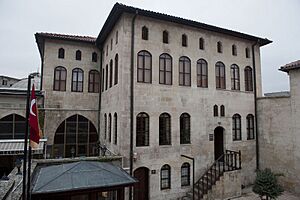
Early History: From Ancient Times to the Middle Ages
Gaziantep is likely the location of the ancient Greek city of Antiochia ad Taurum. This city was known as "Antiochia in the Taurus Mountains."
In its early days, Gaziantep (then called Aintab) was mostly a fortress. It was less important than the city of Dülük, which was about 12 kilometers (7.5 miles) north. Aintab became more important after an earthquake in the 1300s destroyed Dülük.
After the Muslim conquest of the Levant, the region came under the rule of the Umayyads in 661 AD. Then it was ruled by the Abbasids in 750. The city was attacked many times during the wars between the Arabs and Byzantines. Later, it was ruled by different groups like the Tulunids and Hamdanids. In 962, the Byzantines took it back.
In 1067, the Seljuks took control of Aintab. It was even captured by the Crusaders in 1098 and became part of the County of Edessa. The city changed hands many times between different powers like the Seljuk Sultanate of Rûm, the Armenian Kingdom of Cilicia, and the Ayyubids.
By the 1200s, Aintab was the main city of its district. It had busy markets for traders and travelers. However, the city was often fought over. It was attacked by the Mongols in 1270.
Aintab also changed hands many times between the Ilkhanate and the Mamluk Sultanate. Despite these conflicts, the city became known as a "cultured urban center." Scholars came to study there, and it was even called "little Bukhara."
Ottoman Rule and Economic Growth
The Ottoman Empire took control of Gaziantep in 1516, just before the Battle of Marj Dabiq. This was during the rule of Sultan Selim I. Gaziantep became an important center for trade because it was located on key trade routes.
For a long time, Gaziantep had a large Armenian community. Armenians played a big role in the city's history, culture, and economy. They were active in manufacturing, farming, and especially trade. However, these communities no longer exist in the city due to sad events like the Hamidian massacres in 1895 and the Armenian genocide in 1915.
The Ottoman victory in the Battle of Marj Dabiq was very important for Gaziantep. For almost 1,000 years, Gaziantep had been a border city, often attacked. Now, it was in the middle of a large empire. This meant it was more peaceful for about four centuries, until the French occupation in 1921.
After the Ottoman conquest, Gaziantep's economy slowly recovered. By the 1530s, the city was doing well again. This was partly thanks to Süleyman the Magnificent's successful campaign against Safavid Iran in 1534-36. This made trade routes safer in the region. The Ottomans also helped by lowering taxes in newly conquered areas to help them recover.
In the 17th century, a Turkish traveler named Evliya Çelebi visited Gaziantep. He noted that the city had 3,900 shops and two large markets.
By the late 1800s, Gaziantep had about 45,000 people. Most were Muslim, mainly Turkish. There was also a large Armenian Christian community. American Protestant missionaries were active in the city. They founded Central Turkey College in 1874, which mainly served the Armenian community.
Gaziantep in the Republic of Turkey
After World War I, British forces occupied Gaziantep in December 1918. Then, in November 1919, it was given to France. The French Armenian Legion also took part in this occupation. In April 1920, Turkish troops began to besiege the city. This battle lasted 10 months, but the French won. About 6,000 Turkish civilians died during this time.
The French tried to help Armenians who had fled to return to their homes. However, on December 25, 1921, the Treaty of Ankara was signed. As a result, the French left the city.
Some historians say that the fight against the French was also about preventing Armenians from returning and getting their homes back. The same Turkish families who gained wealth from the events of 1915 and 1921-1922 continued to be powerful in the city's politics.
In 2013, Turkey asked NATO to send MIM-104 Patriot missiles to Gaziantep. This was to help protect the city from possible attacks during the Syrian civil war. The request was accepted.
On February 6, 2023, the city was hit by a very strong earthquake. Around 900 buildings collapsed, and over 10,777 others were badly damaged. Many historic buildings, like the Gaziantep Castle and the Liberation Mosque, were also damaged.
Gaziantep's Climate and Weather
Gaziantep has a hot-summer Mediterranean climate. This means it has very hot, dry summers. Winters are cool, wet, and often snowy.
On average, Gaziantep sees about 4.6 snowy days each winter. Snow stays on the ground for about 10 days. The city also gets about 2.5 days of hail.
- The highest temperature ever recorded was 44.0°C (111.2°F) on July 29, 2000, and August 14, 2023.
- The lowest temperature ever recorded was -17.5°C (0.5°F) on January 15, 1950.
| Climate data for Gaziantep (1991–2020, extremes 1940–2023) | |||||||||||||
|---|---|---|---|---|---|---|---|---|---|---|---|---|---|
| Month | Jan | Feb | Mar | Apr | May | Jun | Jul | Aug | Sep | Oct | Nov | Dec | Year |
| Record high °C (°F) | 19.0 (66.2) |
24.3 (75.7) |
28.1 (82.6) |
34.0 (93.2) |
37.8 (100.0) |
40.2 (104.4) |
44.0 (111.2) |
44.0 (111.2) |
40.8 (105.4) |
36.4 (97.5) |
27.3 (81.1) |
25.2 (77.4) |
44.0 (111.2) |
| Mean daily maximum °C (°F) | 8.4 (47.1) |
10.2 (50.4) |
15.0 (59.0) |
20.3 (68.5) |
26.0 (78.8) |
31.9 (89.4) |
36.0 (96.8) |
36.2 (97.2) |
31.8 (89.2) |
25.0 (77.0) |
16.5 (61.7) |
10.4 (50.7) |
22.3 (72.1) |
| Daily mean °C (°F) | 3.9 (39.0) |
5.1 (41.2) |
9.3 (48.7) |
14.0 (57.2) |
19.3 (66.7) |
24.8 (76.6) |
28.7 (83.7) |
28.7 (83.7) |
24.2 (75.6) |
17.7 (63.9) |
10.2 (50.4) |
5.6 (42.1) |
16.0 (60.8) |
| Mean daily minimum °C (°F) | 0.4 (32.7) |
0.9 (33.6) |
4.2 (39.6) |
8.3 (46.9) |
13.0 (55.4) |
18.1 (64.6) |
22.1 (71.8) |
22.1 (71.8) |
17.5 (63.5) |
11.7 (53.1) |
5.4 (41.7) |
1.9 (35.4) |
10.5 (50.9) |
| Record low °C (°F) | −17.5 (0.5) |
−15.6 (3.9) |
−11 (12) |
−4.3 (24.3) |
0.4 (32.7) |
4.5 (40.1) |
9.0 (48.2) |
10.8 (51.4) |
3.4 (38.1) |
−3.9 (25.0) |
−9.7 (14.5) |
−15 (5) |
−17.5 (0.5) |
| Average precipitation mm (inches) | 98.1 (3.86) |
89.6 (3.53) |
68.9 (2.71) |
56.1 (2.21) |
32.9 (1.30) |
9.2 (0.36) |
10.6 (0.42) |
8.5 (0.33) |
13.1 (0.52) |
42.6 (1.68) |
67.5 (2.66) |
104.5 (4.11) |
601.6 (23.69) |
| Average precipitation days | 12.3 | 11.5 | 11.3 | 10.1 | 7.5 | 2.27 | 0.67 | 0.53 | 1.9 | 6.2 | 8.1 | 11.7 | 84.1 |
| Average snowy days | 2.9 | 1.3 | 1.3 | 0 | 0 | 0 | 0 | 0 | 0 | 0 | 0 | 0.4 | 5.9 |
| Average relative humidity (%) | 74.2 | 70.8 | 64.7 | 61.3 | 56.0 | 47.5 | 43.9 | 46.9 | 49.4 | 57.2 | 67.2 | 73.7 | 59.3 |
| Mean monthly sunshine hours | 111.6 | 124.3 | 164.3 | 192.0 | 220.1 | 261.0 | 275.9 | 269.7 | 234.0 | 198.4 | 153.0 | 105.4 | 2,309.7 |
| Mean daily sunshine hours | 3.6 | 4.4 | 5.3 | 6.4 | 7.1 | 8.7 | 8.9 | 8.7 | 7.8 | 6.4 | 5.1 | 3.4 | 6.3 |
| Source 1: Turkish State Meteorological Service | |||||||||||||
| Source 2: NOAA (humidity, 1991-2020), Meteomanz | |||||||||||||
Gaziantep's Economy: A Hub of Trade and Industry
Gaziantep is well-known for its unique local products. These include beautiful copperware and "Yemeni" sandals. The city is a major economic center for southeastern and eastern Turkey.
About 4% of all large industrial businesses in Turkey are in Gaziantep. Small industries make up 6%. Gaziantep also has the largest organized industrial area in Turkey. It is a leader in both exports and imports. The city is also the main place for making Nizip Soap, which uses green olive oil.
In the past, trade in Gaziantep happened in covered markets. These were called 'Bedesten' or 'Hans'. Some famous ones are the Zincirli Bedesten and Hüseyin Pasha Bedesten.
Gaziantep's tourism industry is growing. The area around the castle has been improved. This makes it easier to visit the castle and nearby copper workshops. New restaurants and tourist-friendly shops are opening. Tourists are still quite new to Gaziantep, so locals are very welcoming. Many English-speaking students are happy to help as guides.
Gaziantep is a top producer of machine-made carpets in the world. In 2006, it exported about $700 million worth of these carpets. There are over 100 carpet factories in the Gaziantep Organized Industrial Zone.
With its many olive groves, vineyards, and pistachio farms, Gaziantep is an important farming and industry center in Turkey. Gaziantep is the main place for growing pistachios in Turkey. In 2007, it produced 60,000 metric tons. The Turkish word for pistachio, Antep fıstığı, means "Antep nut" and is named after the city.
Gaziantep is also the main center for processing pistachios in Turkey. About 80% of the country's pistachio processing happens here. This includes shelling, packaging, exporting, and storing. "Antep fıstığı" is a special product in Turkey. It has a protected status since 2000.
In 2009, the biggest shopping center in the city, Sanko Park, opened. It attracted many shoppers, even from nearby Syria. However, relations between Turkey and Syria have become difficult since the Syrian civil war began in 2011.
Who Lives in Gaziantep?
Gaziantep is mostly home to Turks. It also has a large number of Kurds, about 450,000 people. In addition, there are roughly 470,000 Syrian refugees living in the city.
A Look at Gaziantep's Population History
In the early 1300s, an Arab geographer named Dimashki wrote that the people of Aintab were Turkomans. Aintab continued to have a Turkish or Turkoman majority through the 1700s, 1800s, and 1900s.
Armenians lived in Aintab from at least the 900s until the Armenian genocide. By the 1500s, many Armenians in Aintab spoke Turkish instead of Armenian. However, Armenian language use increased again after 1850. The city also had a smaller Jewish community, mostly of Sephardic background. The Jewish population became very small by the 1980s.
Unlike most cities in Southeastern Anatolia, Gaziantep did not have many Kurds until the 1900s. Then, more Kurds moved to the city for economic reasons. By the late 2010s, the Kurdish population grew to about a quarter of the city's total. In the late Ottoman era, some Europeans and Americans also lived in the city. Aintab also had a small Uzbek community from the Ottoman period.
| Languages | Speakers | % |
|---|---|---|
| Turkish | 38,281 | 95.7 |
| Arabic | 873 | 2.2 |
| Kurdish | 491 | 1.2 |
| Other | 359 | 0.9 |
| Total | 40,004 | 100 |
Gaziantep's Rich Culture
Delicious Food: Gaziantep's Famous Cuisine
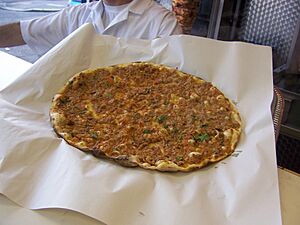

Gaziantep is known for having one of the richest food cultures in Turkey. In 2015, it was the first city in Turkey to be named a City of Gastronomy by UNESCO. In 2013, Gaziantep baklava became the first Turkish product to get a special European protection for its origin.
Travelers over the centuries have often described Aintab's food as "rich." A British traveler in the 1800s even wrote that the king should visit Aintab just to taste its delicious food.
There are many types of kofta (meatballs) in Gaziantep. Some examples are içli küfte (stuffed kofta) and sini küfte. Some koftas don't even have meat, like yapma and malhıtalı küfte (lentil kofta).
Pilafs (rice or bulgur dishes) often go with the main meal. Traditionally, bulgur (cracked wheat) is used for pilafs. These can include orzo (small pasta) or ground beef.
Aintab cuisine also has special Armenian soups. These include vardapet soup and omız zopalı.
Vegetable dishes in Aintab often have meat, but can also be vegetarian. Some popular ones are dorgama, moussaka, and türlü. Dolma (stuffed vegetables) is very common. One type is kış dolması (winter dolma), made with dried vegetables like squash and eggplant.
Common sweets include bastık (fruit leather) and sucuk (nut-filled candy).
Gaziantep's Unique Turkish Dialect
The way Turkish is spoken in Gaziantep is a special local dialect. It is part of the Western Turkish dialects. This dialect has been influenced by Armenian and Arabic. The local dialect is a big part of the city's identity. It is kept alive through funny plays by theater groups like Çeled Uşaglar (meaning "naughty children").
Museums: Exploring Gaziantep's Past and Art
The Gaziantep Museum of Archaeology has many old items. You can see pottery from the Stone Age, and objects from the Bronze Age. There are also items like jewelry, coins, and mosaics from ancient civilizations. These include the Hittite, Roman, and Byzantine periods.
The Zeugma Mosaic Museum is home to mosaics from the ancient city of Zeugma. It has a total of 1,700 square meters (18,000 sq ft) of mosaics. The museum opened on September 9, 2011.
The Hasan Süzer Ethnography Museum is an old stone building that has been restored. It shows what life was like in the past. You can see old weapons, documents, and tools used to defend the city. There are also photos of local heroes.
Other historical sites include the ruins of Zeugma (also called Belkıs) and Kargamış. These are near the town of Nizip. Further north, you can find Rumkale.
The Yesemek Quarry and Sculpture Workshop is an open-air museum. It is about 30 kilometers (19 miles) south of Islahiye. It is the largest open-air sculpture workshop in the Near East. The ruins there date back to the Hittites.
The Gaziantep Defence Museum is located inside the Gaziantep Castle. Before you enter, you see statues of three local heroes: Molla Mehmet Karayılan, Şehit Mehmet Kâmil, and Şahin Bey. Inside, you can hear stories about the Battle of Antep. The museum honors the 6,317 people who died defending the city.
Gaziantep Mevlevi Lodge Foundation Museum The Antep Mevlevi Lodge was built in 1638 as a Mevlevi monastery. This dervish lodge is part of a larger complex around a mosque. In 2007, it opened as the Gaziantep Mevlevi Culture and Foundation Works Museums.
Emine Göğüş Cuisine Museum Gaziantep is famous for its food. A historic stone house built in 1904 has been restored. It is now the Emine Göğüş Cuisine Museum. The museum opened to celebrate the 87th anniversary of Gaziantep's freedom from French occupation.
Historical Places to Visit
Places of Worship
Liberation Mosque was once an Armenian Cathedral. It was turned into a mosque after the city was freed from French forces. The French forces, including the French Armenian Legion, occupied the city from 1918 to 1921.
Boyacı Mosque, a historic mosque, was built between 1211 and 1357. It has one of the world's oldest wooden minbars (a pulpit). This minbar is decorated with verses from the Quran and geometric patterns. Its minaret is a symbol of the city.
Şirvani Mosque is one of Gaziantep's oldest mosques. It is also called İki Şerefeli Cami.
Ömeriye Mosque is said to have been first built during the time of the second Caliph, Omar. This would make it the oldest mosque in Gaziantep. The current mosque was rebuilt in 1850. It is known for its black and red marble mihrab (a niche showing the direction of prayer).
Şeyh Fethullah Mosque was built in 1563. It has Turkish baths and a religious school next to it.
Nuri Mehmet Pasha Mosque was built in 1786. Between 1958 and 1968, it was a museum. After being restored, it became a mosque again.
Ahmet Çelebi Mosque was built in 1672. It is known for its detailed wooden inside.
Tahtani Mosque is a wooden mosque built in 1557. It has a special red marble mihrab.
Alaüddevle Mosque (Ali Dola Mosque) was built between 1479 and 1515. It has been restored recently.
Ali Nacar Mosque is one of the biggest mosques in Gaziantep. It was made larger in 1816.
Eyüpoğlu Mosque was built by a local Islamic saint in the 1300s. It has been restored a lot, so it looks very different from the original.
Kendirli Church was built in 1860 with help from French missionaries and Napoleon III. It is a Catholic Armenian church. It is made of white cut stones on a black stone base.
Bazaars: Shopping in Historic Markets
Zincirli Bedesten is an Ottoman-era covered market. It was built in 1781. This market was used for selling meat, fruit, and vegetables in large amounts.
Bakırcılar çarşısi is Gaziantep's coppersmith bazaar. This craft has been in the region for over 500 years. The bazaar is part of a special cultural route for visitors.
Inns: Old Resting Places
Anatolia Inn: This old inn (caravanserai) was likely built in the early 1800s. It has two floors and two courtyards.
Kürkçü Inn: A classic Ottoman Inn built in 1890.
Old Wheat Inn: The first building was destroyed by fire. The current building was likely built in the 1800s.
Şire Inn: This building has a rectangular shape. It shows many features of old Ottoman inns.
Tobacco Inn: This inn was probably built in the late 1600s.
Yüzükçü Inn: The exact date this inn was built is unknown. An inscription says it was repaired in 1800.
Other Historical Sites
Zeugma is an ancient city. It was built at the shallowest part of the Euphrates river. This area was important for military and trade for centuries. Zeugma was even the headquarters for an important Roman legion.
Gaziantep Castle, also called Gala, is in the city center. It shows the city's long history and old building styles. Digs suggest there were settlements here in the Bronze Age.
Pişirici Kastel is an underground fountain. It was built around 1282. "Kastels" are special to Gaziantep. They are places for washing, praying, and relaxing.
Old houses of Gaziantep: These traditional houses are in the old part of the city. They are made of local stone. They have an inner courtyard called the hayat, which is the main part of the house.
Tahmis Coffee House: This coffee house was built between 1635 and 1638. It was built to provide money for a dervish lodge. The building had two big fires in the early 1900s.

How to Get Around Gaziantep
The city has an airport called Oğuzeli Airport. It has flights to places in Turkey and nearby countries. The city also has a train station, Gaziantep Railway Station, in the center.
Gaziantep has a light rail system called the Gaziantep Tram. It has three lines and is 35 kilometers (22 miles) long. About 75,000 passengers use it every day. The system opened in 2011 and was made longer in 2012 and 2014.
Gaziray is a commuter train line in Gaziantep. It is 25 kilometers (16 miles) long. It is the fourth largest commuter rail system in Turkey. The line has 16 stations, two of which are underground. All stations are easy to use for people with disabilities.
| Rank | Station | Connection | Class | Notes |
|---|---|---|---|---|
| 1 | Baspinar | Level | Gaziantep Organized Industrial Zone | |
| 2 | OSB-3 | Level | Gaziantep Organized Industrial Zone | |
| 3 | OSB-4 | Level | Gaziantep Organized Industrial Zone | |
| 4 | Dolice | Level | Dolice (Dülük) Ancient City | |
| 5 | Stadium | Level | Kalyon Stadium | |
| 6 | Beylerbeyi | Level | ||
| 7 | Fistiklik | Gaziantep Intercity Bus Terminal | Level | |
| 8 | Selimiye | Level | Kayaönü | |
| 9 | Adliye | Underground | Gaziantep Courthouse, Şehitkamil State Hospital, TEDAŞ | |
| 10 | Topraklik | Underground | ||
| 11 | Mucahitler | Level | Dr. Ersin Arslan Training and Research Hospital, SANKO University Hospital, NCR International Hospital | |
| 12 | Gaziantep | Gaziantep Central Railway Station - T1 - T3 | Level | Zeugma Mosaic Museum |
| 13 | Golluce | Level | İnayet Topçuoğlu Hospital | |
| 14 | Seyrantepe | Level | Küsget Industrial Zone | |
| 15 | Mustafa Yavuz | Level | Küsget Industrial Zone | |
| 16 | Taslica | Level | Oduncular Industrial Zone |
Education in Gaziantep
Gaziantep has many schools and universities.
Gaziantep Anatolian High School was founded in 1976. It is a public school that focuses on teaching in English.
Gaziantep Science High School is a public boarding school. It teaches natural sciences and math in Turkish.
There are also other high schools, both private and public. Gaziantep College Foundation is one of the oldest colleges. Its science high school is very successful. Sanko College is a newer but also successful school.
The main campus of Gaziantep University is about 10 kilometers (6 miles) from the city center. It became a state university in 1987. It is one of the largest universities in Turkey, with 27,000 students.
Hasan Kalyoncu University is a private university started in 2008. It has five faculties (departments), three institutes, and three vocational schools.
Zirve University was a private university founded in 2009. It was closed by the government in 2016. Its facilities were given to Gaziantep University.
The newest university in Gaziantep is Sanko University. It started in 2013. It is the first "thematic university" in Turkey, meaning it focuses on specific areas of study.
Sports in Gaziantep
| Club | Sport | Established | League | Venue |
|---|---|---|---|---|
| ALG Spor | Women's football | 1998 | Women's Football Super League | Batur Stadium |
| Gaziantepspor | Football | 1969 | Bölgesel Amatör Lig | New Gaziantep Stadium |
| Gazişehir Gaziantep F.K. | Football | 1988 | Süper Lig | New Gaziantep Stadium |
| Gazikentspor | Women's football | 2006 | Women's Second League | Gazikent Stadium |
| Gaziantep Büyükşehir Belediyespor (Played with sponsporship of Royal Halı since 2012) | Basketball | 2007 | Turkish Basketball League | Kamil Ocak Sports Hall |
| Gaziantep Polis Gücü SK Men's Hockey | Hockey | 2003 | Turkish Hockey Super League | |
| Gaziantep Asyaspor | women's football | 2021 | Women's Football Super League | Aktoprak Football Field |
Beslenspor also played in the Turkish Basketball League from 1986 to 1992.
Gaziantep's City Layout
The oldest part of Gaziantep is located by the Alleben Creek to the north. There are also hills to the south. The city was likely built among these hills because they offered good defense.
Historically, the main trade route went from the castle southeast towards Aleppo. Many inns were built along this road. Because of the hot climate, the city's streets were very narrow. This helped to create more shade from the buildings. Buildings were also placed carefully so that people could not see into each other's private courtyards.
In the past, people often lived in neighborhoods with others from their own ethnic or religious group. Around World War I, Muslims lived in the eastern parts of the city. Non-Muslims, mostly Armenians, lived in the western parts. Jews lived in the Düğmeci and Karagöz districts.
The Jansen Plan (1938): Shaping the Modern City
In 1938, the city asked Hermann Jansen to create a new plan for Gaziantep. This was the first big city planning effort. Many of his ideas were put into action.
The Jansen plan aimed to keep the old feel of Gaziantep. But it also planned new areas outside the old city. It focused on developing the north, south, and west sides of the city. New industrial areas were planned along important roads, especially the Nizip and Aleppo roads. A large industrial zone was planned for the north side. It was chosen to be in the northeast so that air pollution would not blow over the city.
The plan also made big changes to the city's transportation. A railway line was added to connect Gaziantep to the national train system. Jansen wanted the train station on the north side. This area was flatter, and it would not separate the old town from new residential areas.
Jansen also planned new wide roads and made existing ones wider. This created a better transportation network. He wanted to combine the Narlı and Aleppo roads into İsmet İnönü Caddesi, which would be the main road. The plan also aimed to connect other important roads. An airport was also proposed on the west side of town.
A very important part of the Jansen Plan was a green belt along Alleben Creek. This area would have no buildings and would be a large park. Jansen also suggested an area for sports fields, but these were never built.
New housing areas were planned to the south of the old city. Jansen wanted these new areas to have two-story houses on streets that followed the hills. He also suggested moving the old cemetery to a new location in the northeast to make space for new homes.
For new government buildings, Jansen chose the Çukurbostan area in the old city center. He even suggested tearing down some old buildings to make space.
How the Jansen Plan Changed Gaziantep
Many parts of the Jansen plan were built. It greatly influenced how Gaziantep grew in the 1900s. The railway line on the north side and new main roads were all built. The commercial areas also grew along the old Aleppo road.
However, the airport area he suggested was never built. It became a residential area instead. The planned housing expansion to the south happened, and the cemetery was moved. But most new homes were built to the northwest. This was because the southern hills were harder to build on.
One problem with the Jansen plan was that it did not expect how much the city's population would grow. This led to unplanned settlements. Also, Jansen's idea of not changing the old city center much did not work perfectly. Many old buildings fell apart and were replaced with new ones that did not fit the old style.
Later City Plans: Adapting to Growth
By the 1950s, Gaziantep was growing very fast. New unplanned settlements appeared. So, a new city plan was made in 1955 by Kemal Ahmet Aru and Hamit Kemali Söylemezoğlu. This plan continued Jansen's ideas but added some changes.
The main goal of this new plan was to provide housing for the growing population. It also aimed to shift the economy from farming to industry. Important new features included the current railway station and a new highway. New upscale neighborhoods were planned to the southwest. The plan generally used a grid pattern for city streets.
Areas north of Alleben Creek, which were supposed to be parks, became residential areas. Some new industrial areas were also developed.
In 1973, a third city plan was created by Zühtü Can and his team. This plan aimed to guide the city's growth until 1995, expecting a population of 1 million. The Can plan focused on making Gaziantep an industrial center. Industrial areas were increasingly separated from living areas. The plan imagined a city with industrial areas at the west and east ends, and new homes in the south.
The 1970s saw the most people moving to Gaziantep. New homes were built in two main areas. One was in the south and east, near factories. The other was in the north and west, for people with higher incomes.
By the mid-1980s, illegal building started to affect the Can plan. The city tried to fix this, but it led to parts of the city not being well connected.
In 1990, a fourth plan was made by H. Oğuz Aldan. This plan aimed for a population of about 1.8 million by 2005. It planned for the city to grow to 8010 hectares (19,793 acres). A new ring road helped growth in the west and south. New commercial areas were also built, like the Gaziantep Trade and Industry Center (GATEM).
Gaziantep in the 2000s
Since the 2000s, many smaller projects have taken place. These include redeveloping industrial areas and improving unplanned settlements. Various other development projects are also happening across the city.
Gaziantep Zoo: A Home for Animals
The Gaziantep Zoo is one of the biggest zoos in Turkey. It has a great bird pavilion and an aquarium. The zoo offers many different animals, nice picnic areas, and a cafeteria. It covers an area of 1,000,000 square meters (247 acres). There are 264 species and 6,814 animals living there.
Gaziantep's International Connections
Twin Towns and Sister Cities
Gaziantep has "twin town" or "sister city" relationships with other cities around the world. This means they share cultural ties and promote friendship.
 Aleppo, Syria
Aleppo, Syria Aryanah, Tunisia
Aryanah, Tunisia Cetinje, Montenegro
Cetinje, Montenegro Duisburg, Germany
Duisburg, Germany Irbid, Jordan
Irbid, Jordan Karlstad, Sweden
Karlstad, Sweden Kermanshah, Iran
Kermanshah, Iran Kharkiv, Ukraine
Kharkiv, Ukraine Kuwait City, Kuwait
Kuwait City, Kuwait Ludwigshafen am Rhein, Germany
Ludwigshafen am Rhein, Germany Nicosia, Cyprus
Nicosia, Cyprus
 Ostrava, Czech Republic
Ostrava, Czech Republic Sabaragamuwa, Sri Lanka
Sabaragamuwa, Sri Lanka Tripoli, Lebanon
Tripoli, Lebanon Celje, Slovenia
Celje, Slovenia
Famous People from Gaziantep
- See Category:People from Gaziantep
Images for kids
See also
 In Spanish: Gaziantep para niños
In Spanish: Gaziantep para niños


